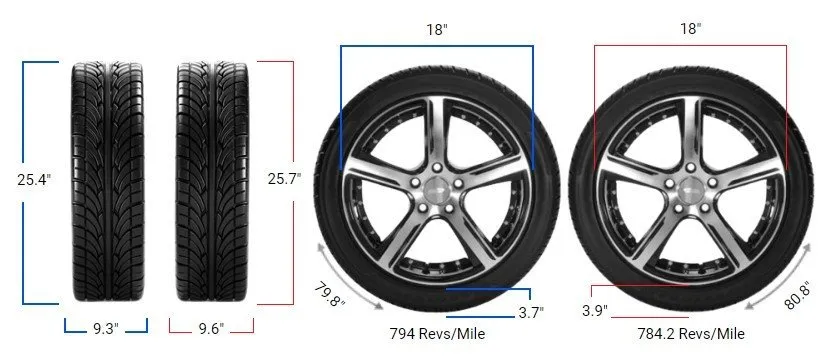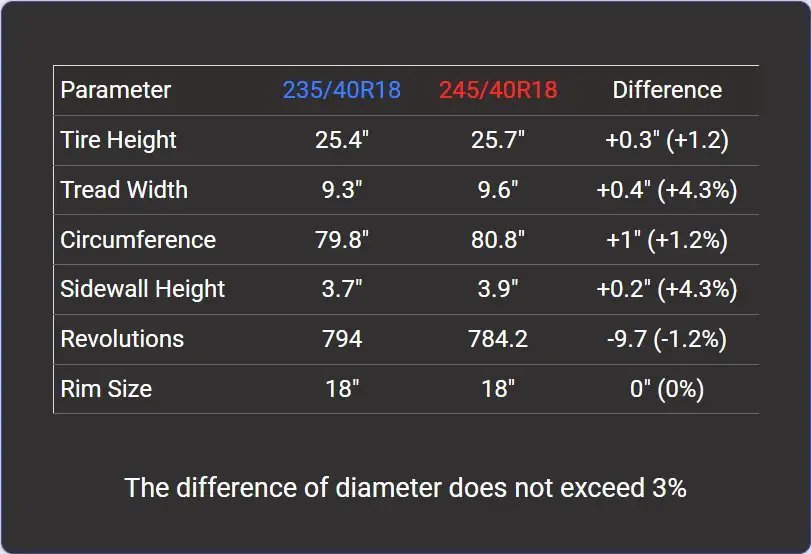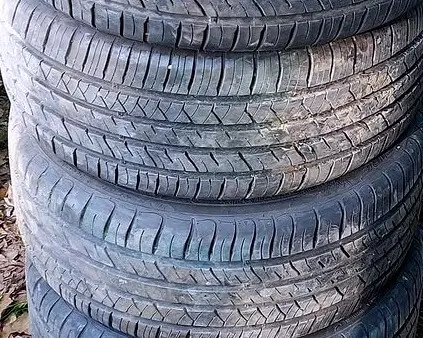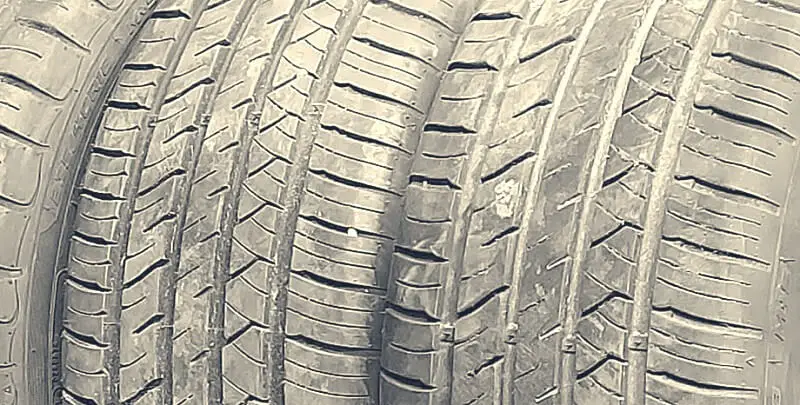Tire Size 235/40r18 vs 245/40r18

Tire upgrades can significantly impact your vehicle’s performance and appearance. This article explores the effects of switching from 235/40r18 to 245/40r18 tires, examining both benefits and potential drawbacks.
- The diameter increase of 1.2% is within the acceptable 3% range.
- Wider tires may improve grip and cornering performance.
- Slightly taller sidewalls could enhance ride comfort.
- Minimal impact on speedometer accuracy and fuel efficiency.
- Potential for improved aesthetics with a wider, more aggressive look.
The main difference between 235/40R18 and 245/40R18 tires is the section width. This means the 245/40R18 tire is 10 millimeters wider than the 235/40R18 tire.

Fitment Guide
It’s crucial to stay within the recommended 3% diameter difference. In this case, the 245/40r18 tires have a diameter of 25.72 inches, compared to 25.4 inches for the 235/40r18.
This 1.2% increase falls well within the acceptable range, making the interchange safe and recommended.
On-Road Impact
The switch to 245/40r18 tires can affect various aspects of on-road performance. Let’s explore these impacts in detail:
- Traction and Handling: The wider 245/40r18 tires offer a larger contact patch with the road. This increased surface area can improve grip, especially during cornering and in wet conditions. Drivers may notice enhanced stability and more confident handling, particularly during aggressive maneuvers or high-speed driving.
- Ride Comfort: The slightly taller sidewall of the 245/40r18 tires (3.86 inches vs. 3.7 inches) provides a marginal increase in tire cushioning. This could result in a slightly smoother ride, absorbing small road imperfections more effectively. However, the difference is minimal and may not be noticeable to all drivers.
- Speedometer Accuracy: The 1.2% increase in overall diameter will cause a slight discrepancy in speedometer readings. At 20 mph, the actual speed will be 20.25 mph. This difference is negligible in most situations but could accumulate over long distances. Drivers should be aware of this small variation, especially when relying on precise speed measurements.
- Fuel Efficiency: The wider tires may create slightly more rolling resistance, potentially impacting fuel economy. However, the difference is likely to be minimal, with most drivers experiencing little to no noticeable change in their vehicle’s gas mileage.
- Aesthetics: The wider 245/40r18 tires can give your vehicle a more aggressive and sporty appearance. The additional 10mm of width fills out the wheel wells more, creating a muscular look that many car enthusiasts appreciate.

Off-Road Impact
While these tire sizes are primarily designed for on-road use, their differences can still affect off-road performance:
- Ground Clearance: The 0.31-inch increase in overall diameter translates to a marginal gain in ground clearance. This slight boost may provide a small advantage when navigating rough terrain or obstacles, but the impact is minimal for most off-road scenarios.
- Traction: The wider 245/40r18 tires can offer improved grip on loose surfaces like gravel or light mud. The larger contact patch helps distribute the vehicle’s weight more effectively, potentially reducing the risk of getting stuck in soft conditions.
Durability & Wear
The difference in tire dimensions may affect longevity and wear patterns:
- Tread Life: The wider 245/40r18 tires have a larger contact patch, which can lead to more even wear across the tread surface. This may result in slightly improved tread life, although factors like driving style and road conditions play a more significant role in overall tire longevity.
- Rotation Patterns: The minimal size difference shouldn’t affect standard tire rotation practices. However, it’s essential to follow manufacturer recommendations and maintain proper tire pressure to ensure even wear across all four tires.

What is the Difference Between 235/40r18 and 245/40r18?
The main difference between 235/40r18 and 245/40r18 tires is their width. The 245/40r18 tire is 10mm (0.39 inches) wider than the 235/40r18.
This increased width results in a larger contact patch with the road, potentially improving traction and handling characteristics. The wider tire also contributes to a slightly more aggressive and sporty appearance, which many car enthusiasts prefer.
Can I Use 245/40r18 Instead of 235/40r18?
Yes, you can generally use 245/40r18 tires instead of 235/40r18 tires. The overall diameter increase of 1.2% falls well within the recommended 3% tolerance range for tire size changes.
This means the switch should not significantly impact your vehicle’s performance, speedometer accuracy, or safety systems. However, it’s always best to consult your vehicle’s manual or a professional to ensure compatibility with your specific make and model.
How Much Taller Is a 245/40r18 Tire Than a 235/40r18?
A 245/40r18 tire is 0.31 inches (8mm) taller than a 235/40r18 tire. The 245/40r18 has a diameter of 25.72 inches (653.2mm), while the 235/40r18 has a diameter of 25.4 inches (645.2mm).
This represents a 1.2% increase in overall diameter, which is a relatively small change and falls within the acceptable range for tire size alterations.
How Much Wider is a 245/40r18 Tire Than a 235/40r18?
A 245/40r18 tire is 0.39 inches (10mm) wider than a 235/40r18 tire. The 245/40r18 has a width of 9.65 inches (245mm), while the 235/40r18 has a width of 9.25 inches (235mm).
This 4.3% increase in width is the most noticeable dimensional change between the two tire sizes and can lead to improved traction and a more aggressive appearance.
235/40r18 vs 245/40r18 Table
Comparing tire sizes 235/40R18 and 245/40R18 reveals key differences in diameter, width, and performance.
| Parameter | 235/40R18 | 245/40R18 | Difference |
|---|---|---|---|
| Tire Height | 25.4″ | 25.7″ | +0.3″ |
| Tire width | 9.3″ | 9.6″ | +0.4″ |
| Circumference | 79.8″ | 80.8″ | +1.0″ |
| Sidewall height | 3.7″ | 3.9″ | +0.2″ |
| Revs per mile | 794.0 | 784.2 | -9.7 |
| Rim size | 18″ | 18″ | 0.0″ |
| Speedometer | 20 mph | 20.25 mph | 0.25 mph |
Our Observation
Switching from 235/40r18 to 245/40r18 tires offers several benefits with minimal drawbacks. The wider tires provide improved traction and handling, enhancing overall driving dynamics.
The slightly taller sidewalls contribute to a marginally smoother ride, while the aggressive look appeals to many enthusiasts. However, these advantages come with potential trade-offs, such as a minor decrease in fuel efficiency and a slight speedometer discrepancy.
For most drivers, these effects will be negligible in both on-road and off-road scenarios. The 1.2% diameter increase ensures compatibility with vehicle systems, making this upgrade a safe and potentially rewarding choice for those seeking enhanced performance and aesthetics.

Meet Caitlin McCormack, a Tire Size Expert and Blogger Passionate About Everything Related to Tires. With Years of Experience in the Tire Industry, Caitlin Has Become an Expert in Tire Sizes and Their Impact on Vehicle Performance.
